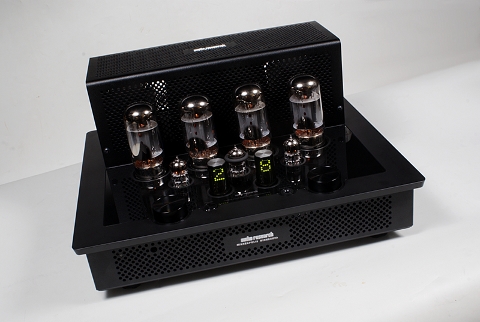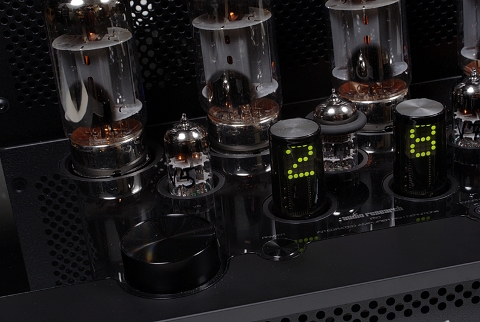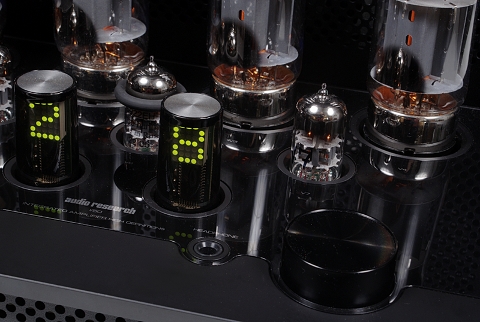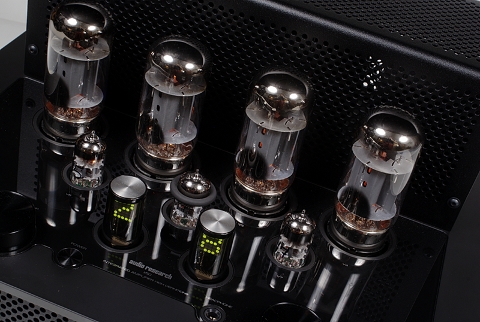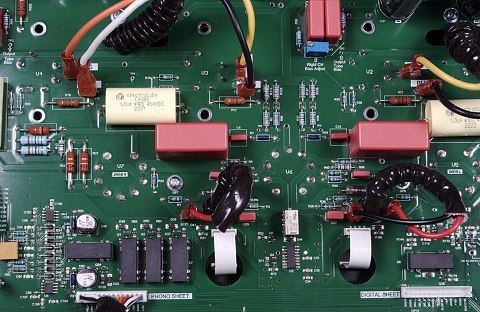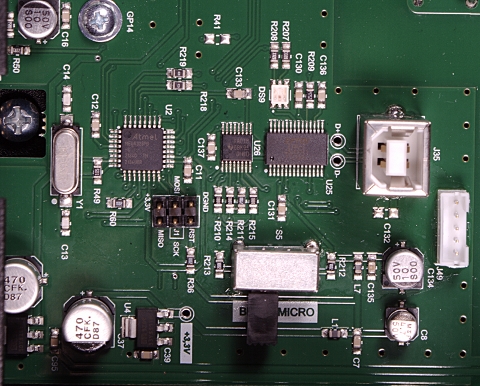about Audio, High Fidelity
& Home Entertainment technologies
pid: 607-2025/10/01 (v1.2)
Privacy Policy

If it were up to me, I would have left with the red or the yellow/ochre I/50, a matter purely of personal preference. However, what I received was the conventional black version. Such is the life of the reviewer. The option of color selection (from a palette of six) is, of course, unrelated to the product's capabilities as an amplifier, yet it nevertheless provides a sense of freedom of choice. Modern homes can accommodate something different, and a system based on an amplifier finished in a vivid color is a positive addition. Therefore, choose carefully, but also boldly!
The I/50 features a construction that successfully combines refined quality and aesthetics with the classic structure (exposed tubes and transformers housed in a cage) and the modern: the encoders, the on/off switch, and the headphone output are positioned on the horizontal surface. The two LexieTubes, which display basic operational information, are the true visual highlight.
Beyond its conventionality, however, the black finish highlights, through its seriousness, the very carefully considered aesthetics of the device. A highly reflective horizontal surface surrounded by matte aluminum, a heavy perforated chassis that facilitates ventilation, and a classical architecture (tubes in front, cage with output and power transformers in the rear), which is complemented by an additional cage protecting the surroundings from the hot tubes, is further accompanied by two horizontally placed encoders, a headphone output (TRS 6.35mm), and two very interesting indicators. Audio Research calls these LexieTubes (and holds the relevant patent) and uses them to display the essential information pertaining to the device’s operation. Here appear the selected input, the volume level, and warm-up delay (the tubes need some time to heat-up), the standby status, and the mute function. Their cylindrical form fits perfectly with the tubes, and, in terms of construction, they are LED arrays. A fine idea, for sure, which imparts character to the I/50.
The user has at their disposal a rotary input selector. The on/off switch powers the device, but can also place it in stand-by mode, during which the tubes cease operating, though the rest of the circuitry remains active.
The volume control, when pressed, activates the muting function. Directly beside it, the headphone output is located.
In its basic version, the I/50 offers only the essentials: four line-level inputs, three single-ended (with RCA connectors of standard quality), and one XLR. The loudspeaker connection is made via very high-quality terminals, with taps for 8Ω and 4Ω loads and the ability to use all the classical cable terminations, although the limited height of the rear surface makes the use of oversized cables and connectors somewhat difficult.
I mentioned the “basic version” because the I/50 is expandable via two slots for module installation. The user may sacrifice one of the single-ended inputs and install a phono preamplifier for MM cartridges (or high-output MC—though I am of the opinion that, in this price category, there ought also to be an option for a low-output MC too) and may use the second slot for the installation of a seemingly complete DAC, based on an Asahi Kasei chip, offering standard digital inputs S/PDIF (coaxial and optical), a USB-B port for streaming from a computer, as well as ad-hoc streaming via Bluetooth. One of the line inputs may be used as a pass-through, allowing the integrated amplifier to be employed as part of a multichannel system. The device is accompanied by a remote control, small in dimensions yet metallic and of high quality.
The I/50 is based on two 6550 pentodes per channel, and features a 6922 double triode as a driver, and half a 6922 for the input stage. The latter is equipped with a damping ring to reduce microphonics.
Small in size yet elegant and with a pleasing tactile quality, the remote control contributes to the overall user experience.
The I/50 is a classical tube amplifier with a push-pull power stage, based on two matched 6550 beam power pentodes per channel. The driving of the power stage is handled by two 6922 dual triodes (one per channel), while the input stage is implemented by an additional 6922 (shared by both channels). This last one, includes a damping ring against vibrations, so that the sensitive input signal is not burdened by acoustic feedback and microphonics.
The interior of the device reveals a carefully executed construction on a single printed circuit board, with high-quality components at critical points and the tube sockets mounted directly on the PCB. There is a local regulation circuit, with the relevant integrated circuits cooled by a (completely silent) fan positioned at the base of the chassis. Audio Research does not promote the idea of experimentation with output tubes, but rather the use of matched tubes supplied by the company (according to the user manual, the preamplifier tubes should be replaced before 4,000 hours, and the power tubes before 2,000 hours). This is also reflected in the fact that the user has no means of viewing the bias current, nor of measuring or adjusting it. The relevant test points are located inside the device, accessible under normal conditions only to an authorized technician.
A basic connectivity package is provided, which, however, may be expanded with a phono preamplifier (on the left) and a digital-to-analog converter (on the right). The amplifier offers taps for connecting speakers of 8Ω and 4Ω.
The construction is meticulous, with quality materials used where necessary. At the upper left, one can discern the sealed phono module, at the lower left the local regulation, and at the bottom center the headphone amplifier.
The tube sockets are mounted directly on the printed circuit board (the driver tubes sockets and the input tube socket are visible). At the upper part of the photograph, one can observe the bias control circuitry with its multi-turn trimmer and the test point.
Previous | Next | More Reviews

